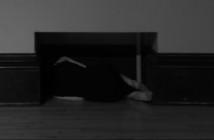Originally performed at the Museum of Contemporary Art in Chicago during Without You I’m Nothing: Art and Its Audience, Mnemonic consists of inviting the public to get a small permanent black dot on their body, wherever they choose. "The piece came out of my interest in self-made identities and group cultures. I am interested in what individuals must give up in order to become a part of a larger group," said Katrina Chamberlin.
During its two-day duration in Boston, 30 participants, myself included, chose to give up a small part of their individuality by allowing themselves to be marked with an identical blue dot. "Even though it is a very small commitment, it is a permanent one," said Chamberlin, adding that she's curious about the juxtaposition of minimalist images with gestures of pain and violence.
The Grossman Gallery at the Museum School was transformed into a tattoo parlor with participants surrounded by minimalist works made in the last 40 years. It was fitting that the chair was anchored between Lewitt’s Wall Drawing #118 and Sphère 1m69 a circle traced with razor wire by the French artist Adel Abdessemed. The burning sensation of the needle puncturing my flesh was soon forgotten as I started to think about my identity and how much it might change as a result of this experience. As I lay on the chair, staring at Lewitt’s drawing, it became clear that I was now a random point part of a larger network of dots.
Conceived at a time Chamberlin was making work about identity and what it meant to be part of a group, Mnemonic has created a network of 162 (30 during the Boston installment of this performance) strangers connected by a permanent black or blue dot.
It’s only been 12 years since the state of Massachusetts lifted the ban on tattoos. Due to Board of Health regulations, the tattoos for this Boston performance were administered by Suze, a tattoo artist based in Cambridge. Chamberlin was present for the entire duration of the performance.
"In this new form, the dot becomes less attached to myself and authorship and more of a mark shared among the participants." She added drawing connections between Sol Lewitt’s instructions for his wall drawings and some works in the exhibition with similar instructions for their creation and installation by hands other than the author.
Mnemonic shares more in common with Felix Gonzalez-Torres’ "Untitled" (1990) than with Lewitt's Wall Drawing #118 or any other piece in the show. Composed of three stacks of paper with an identical blue line running down the center, "Untitled" flirts with the viewer and ideas of permanence and impermanence. Here, Gonzalez-Torres invites his viewers to interact with the work by taking home a piece of it with them, much like Chamberlin’s participants in Mnemonic flirt with the tattoo artist and walk away with an identical permanent mark on their body. In both of these works, the viewer creates their own personal meaning for otherwise common materials and body adornments.
While I don’t feel a strong connection with the other 29 people that got marked for this performance, I do hope that this experience allows for a serendipitous moment where two of us strangers connect over our blue dots in the future. It may happen. And while I may have given up a part of my individuality, I can’t help but think there are 29 other people who gave up a small part of themselves to become part of a much larger network.
- The author getting marked in preparation for his permanent tattoo.
- SMFA: Installation shot from “Something Along Those Lines” at the School of the Museum of Fine Arts, Boston. Photo: George Bouret.
LAST CHANCE: "Something Along Those Lines" is on view until November 3, 2012 at the SMFA's Barbara and Steven Grossman Gallery.






